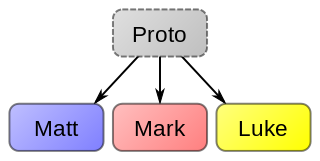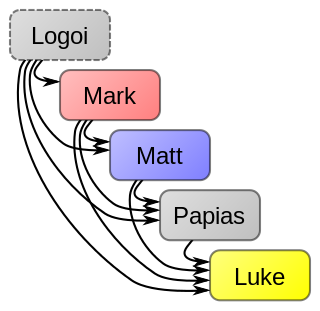Gospel originally meant the Christian message, but in the 2nd century it came to be used also for the books in which the message was reported. In this sense a gospel can be defined as a loose-knit, episodic narrative of the words and deeds of Jesus, culminating in his trial and death and concluding with various reports of his post-resurrection appearances. Modern biblical scholars are cautious of relying on the gospels uncritically, but nevertheless, they provide a good idea of the public career of Jesus, and critical study can attempt to distinguish the original ideas of Jesus from those of the later Christian authors.

Marcan priority is the hypothesis that the Gospel of Mark was the first of the three synoptic gospels to be written, and was used as a source by the other two. It is a central element in discussion of the synoptic problem; the question of the documentary relationship among these three gospels.

The two-source hypothesis is an explanation for the synoptic problem, the pattern of similarities and differences between the three Gospels of Matthew, Mark, and Luke. It posits that the Gospel of Matthew and the Gospel of Luke were based on the Gospel of Mark and a hypothetical sayings collection from the Christian oral tradition called Q.

The gospels of Matthew, Mark, and Luke are referred to as the synoptic Gospels because they include many of the same stories, often in a similar sequence and in similar or sometimes identical wording. They stand in contrast to John, whose content is largely distinct. The term synoptic comes via Latin from the Greek σύνοψις, synopsis, i.e. "(a) seeing all together, synopsis"; the sense of the word in English, the one specifically applied to these three gospels, of "giving an account of the events from the same point of view or under the same general aspect" is a modern one.

The Farrer hypothesis is a possible solution to the synoptic problem. The theory is that the Gospel of Mark was written first, followed by the Gospel of Matthew and then by the Gospel of Luke.

M source, which is sometimes referred to as M document, or simply M, comes from the M in "Matthean material". It is a hypothetical textual source for the Gospel of Matthew. M Source is defined as that 'special material' of the Gospel of Matthew that is neither Q source nor Mark.

The Gospel of Marcion, called by its adherents the Gospel of the Lord, or more commonly the Gospel, was a text used by the mid-2nd-century Christian teacher Marcion of Sinope to the exclusion of the other gospels. The majority of scholars agree that this gospel was a later revised version of the Gospel of Luke, though several involved arguments for Marcion priority have been put forward in recent years.

The Augustinian hypothesis is a solution to the synoptic problem, which concerns the origin of the Gospels of the New Testament. The hypothesis holds that Matthew was written first, by Matthew the Evangelist. Mark the Evangelist wrote the Gospel of Mark second and used Matthew and the preaching of Peter as sources. Luke the Evangelist wrote the Gospel of Luke and was aware of the two Gospels that preceded him. Unlike some competing hypotheses, this hypothesis does not rely on, nor does it argue for, the existence of any document that is not explicitly mentioned in historical testimony. Instead, the hypothesis draws primarily upon historical testimony, rather than textual criticism, as the central line of evidence. The foundation of evidence for the hypothesis is the writings of the Church Fathers: historical sources dating back to as early as the first half of the 2nd century, which have been held as authoritative by most Christians for nearly two millennia. Adherents to the Augustinian hypothesis view it as a simple, coherent solution to the synoptic problem.
The criterion of multiple attestation, also called the criterion of independent attestation or the cross-section method, is a tool used by Biblical scholars to help determine whether certain actions or sayings by Jesus in the New Testament are from the Historical Jesus. Simply put, the more independent witnesses that report an event or saying, the better. This criterion was first developed by F. C. Burkitt in 1906, at the end of the first quest for the historical Jesus.
Robert Lisle Lindsey (1917–1995), founded together with David Flusser the Jerusalem School of Synoptic Research.
The historical reliability of the Gospels is evaluated by experts who have not found a complete consensus. While all four canonical gospels contain some sayings and events which may meet one or more of the five criteria for historical reliability used in biblical studies, the assessment and evaluation of these elements is a matter of ongoing debate. Virtually all scholars of antiquity agree that a human Jesus existed, but scholars differ on the historicity of specific episodes described in the biblical accounts of Jesus, and the only two events subject to "almost universal assent" are that Jesus was baptized by John the Baptist and was crucified by the order of the Roman Prefect Pontius Pilate. Elements whose historical authenticity is disputed include the two accounts of the Nativity of Jesus, the miraculous events including the resurrection, and certain details about the crucifixion.

The three-source hypothesis is a candidate solution to the synoptic problem. It combines aspects of the two-source hypothesis and the Farrer hypothesis. It states that the Gospel of Matthew and the Gospel of Luke used the Gospel of Mark and a sayings collection as primary sources, but that the Gospel of Luke also used the Gospel of Matthew as a subsidiary source. The hypothesis is named after the three documents it posits as sources, namely the sayings collection, the Gospel of Mark, and the Gospel of Matthew.

The Jerusalem School Hypothesis is one of many possible solutions to the synoptic problem, that the Gospel of Luke and the Gospel of Matthew both relied on older texts which are now lost. It was developed by Robert Lindsey, from the Jerusalem School of Synoptic Research.

The two-gospel hypothesis or Griesbach hypothesis is that the Gospel of Matthew was written before the Gospel of Luke, and that both were written earlier than the Gospel of Mark. It is a proposed solution to the synoptic problem, which concerns the pattern of similarities and differences between the three Gospels of Matthew, Mark, and Luke. The hypothesis is generally first credited to Johann Jakob Griesbach writing in the 1780s; it was introduced in its current form by William R. Farmer in 1964 and given its current designation of two-gospel hypothesis in 1979.

The Q source (also called The Sayings Gospel, Q Gospel, Q document(s), or Q; from German: Quelle, meaning "source") is a hypothetical written collection of primarily Jesus' sayings (λόγια : logia). Q is part of the common material found in the Gospels of Matthew and Luke but not in the Gospel of Mark. According to this hypothesis, this material was drawn from the early Church's oral gospel traditions.

Oral gospel traditions is the hypothetical first stage in the formation of the written gospels as information was passed by word of mouth. These oral traditions included different types of stories about Jesus. For example, people told anecdotes about Jesus healing the sick and debating with his opponents. The traditions also included sayings attributed to Jesus, such as parables and teachings on various subjects which, along with other sayings, formed the oral gospel tradition. The supposition of such traditions have been the focus of scholars such as Bart Ehrman, James Dunn, and Richard Bauckham, although each scholar varies widely in his conclusions, with Ehrman and Bauckham publicly debating on the subject.

In textual criticism of the New Testament, the L source is a hypothetical oral or textual tradition which the author of Luke–Acts may have used when composing the Gospel of Luke.

The Hebrew Gospel hypothesis is that a lost gospel, written in Hebrew or Aramaic, predated the four canonical gospels. Some have suggested a complete unknown proto-gospel as the source of the canonical gospels. This hypothesis is usually based upon an early Christian tradition from the 2nd-century bishop Papias of Hierapolis. According to Papias, Matthew the Apostle was the first to compose a gospel, and he did so in Hebrew. Papias appeared to imply that this Hebrew or Aramaic gospel was subsequently translated into the canonical Gospel of Matthew. Jerome took this information one step further and claimed that all known Jewish-Christian gospels really were one and the same, and that this gospel was the authentic Matthew. As a consequence he assigned all known quotations from Jewish-Christian gospels to the "gospels of the Hebrews", but modern studies have shown this to be untenable. Modern variants of the hypothesis survive, but have not found favor with scholars as a whole.

Advanced by Dennis R. MacDonald, the Q+/Papias hypothesis (Q+/PapH) offers an alternative solution to the synoptic problem. MacDonald prefers to call this expanded version of Q Logoi of Jesus, which is supposed to have been its original title.

The Matthean Posteriority hypothesis, also known as the Wilke hypothesis after Christian Gottlob Wilke, is a proposed solution to the synoptic problem, holding that the Gospel of Mark was used as a source by the Gospel of Luke, then both of these were used as sources by the Gospel of Matthew. Thus, it posits Marcan priority and Matthaean posteriority.















